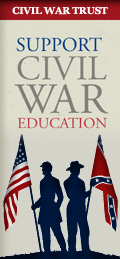Tales Behind the Photos
By C.D. Myers
Knight Ridder Newspapers
November 7, 2004
Written accounts of the American Civil War abound. Some books offer sweeping views of the war years, from 1861 to 1865. Others recount in rich detail epic clashes between Union and Confederate forces at now legendary battles.
The lives of the war's principle military commanders, in particular Union generals Ulysses S. Grant and William Tecumseh Sherman and Confederate leaders Robert E. Lee and Thomas "Stonewall" Jackson, have likewise enjoyed plenty of ink in biographies over time.
Now it's time for the enlisted men and junior officers, who bore both the brunt of battle and performed mundane military duties at their respective levels, to get their due.
Faces of the Civil War is one of those rare prizes that has multiple entry points. A person can start on any page and work forward or backward through the stories that chart along a loose chronology of the Civil War years. Wherever one chooses to start this book, it decidedly puts its hooks into a reader's interest even before the first selected story is completed.
Several of Coddington's stories relate the largely unheralded gallantry of the soldiers at some of the conflict's most famous engagements, from Bull Run in 1861 and Hell's Half Acre at Shiloh in 1862 to the nasty fight waged at The Wilderness in 1864. Other accounts detail the actions by soldiers at lesser-known battles of the war, such as at Port Hudson, La., in 1863. In each instance, Coddington provides an exceptional insight into the Civil War battlefield experience, boiling down large, ranging engagements into the few dozen yards over which his soldiers fought.
While some of Coddington's troops survived the war by many years, sme didn't get past their first battlefield action. With biting clarity, Coddington describes the horrific combat injuries sldiers suffered, and the debilitating illnesses that ften knocked them out of the war — permanently.
The attention to detail in each story reflects the quality, top-level research effort behind Faces of the Civil War. When he embarked on the book, Coddington often had precious little to go on, beyond an occasional name written or printed on the images. But through meticulous examination of individual service, pension and medical records at the National Archives in Washington, he was able to reconstruct the lives of these soldiers.
Faces of the Civil War not only exhibits Coddington's appreciation and understanding of Civil War history but also his passion for early photography, specifically, the roughly baseball card-size carte de visite portrait image. The photograhs used to illustrate Faces of the Civil War came from Coddington's personal collection of cartes de visite, which he acquired over the course of many years.
Developed in France during the mid-1850s, the carte de visite enjoyed widespread popularity in the United States prior to the Civil War. Many Union soldiers sat for carte de visite images at photo studios before heading off into the field.
These images held imense sentimental value for the families and loved ones of soldiers serving in the Union army. Similar images of Confederate soldiers however, are ar less prevalent, an actuality that lies behind Coddington's decision to focus only on Union soldiers in this book.
While Faces of the Civil War certainly pays homage to the men who volunteered for the Union army, the book also shows that not every soldier performed with distinction during the war. Some soldiers had troube with military life and combat, and suffered terrible, often tragic, emotional breakdowns.
|
